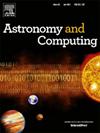Bridging gaps with computer vision: AI in (bio)medical imaging and astronomy
IF 1.8
4区 物理与天体物理
Q2 ASTRONOMY & ASTROPHYSICS
引用次数: 0
Abstract
This paper explores how artificial intelligence (AI) techniques can address common challenges in astronomy and (bio)medical imaging. It focuses on applying convolutional neural networks (CNNs) and other AI methods to tasks such as image reconstruction, object detection, anomaly detection, and generative modeling. Drawing parallels between domains like MRI and radio astronomy, the paper highlights the critical role of AI in producing high-quality image reconstructions and reducing artifacts. Generative models are examined as versatile tools for tackling challenges such as data scarcity and privacy concerns in medicine, as well as managing the vast and complex datasets found in astrophysics. Anomaly detection is also discussed, with an emphasis on unsupervised learning approaches that address the difficulties of working with large, unlabeled datasets. Furthermore, the paper explores the use of reinforcement learning to enhance CNN performance through automated hyperparameter optimization and adaptive decision-making in dynamic environments. The focus of this paper remains strictly on AI applications, without addressing the synergies between measurement techniques or the core algorithms specific to each field.

弥合与计算机视觉的差距:人工智能在(生物)医学成像和天文学中的应用
本文探讨了人工智能(AI)技术如何解决天文学和(生物)医学成像中的共同挑战。它专注于将卷积神经网络(cnn)和其他人工智能方法应用于图像重建、对象检测、异常检测和生成建模等任务。通过对比MRI和射电天文学等领域,该论文强调了人工智能在产生高质量图像重建和减少人工制品方面的关键作用。生成模型被视为解决医学中数据稀缺和隐私问题等挑战的通用工具,以及管理天体物理学中发现的庞大而复杂的数据集。还讨论了异常检测,重点是无监督学习方法,该方法解决了处理大型未标记数据集的困难。此外,本文探讨了在动态环境中使用强化学习,通过自动超参数优化和自适应决策来提高CNN的性能。本文的重点仍然是严格的人工智能应用,没有解决测量技术或特定于每个领域的核心算法之间的协同作用。
本文章由计算机程序翻译,如有差异,请以英文原文为准。
求助全文
约1分钟内获得全文
求助全文
来源期刊

Astronomy and Computing
ASTRONOMY & ASTROPHYSICSCOMPUTER SCIENCE,-COMPUTER SCIENCE, INTERDISCIPLINARY APPLICATIONS
CiteScore
4.10
自引率
8.00%
发文量
67
期刊介绍:
Astronomy and Computing is a peer-reviewed journal that focuses on the broad area between astronomy, computer science and information technology. The journal aims to publish the work of scientists and (software) engineers in all aspects of astronomical computing, including the collection, analysis, reduction, visualisation, preservation and dissemination of data, and the development of astronomical software and simulations. The journal covers applications for academic computer science techniques to astronomy, as well as novel applications of information technologies within astronomy.
 求助内容:
求助内容: 应助结果提醒方式:
应助结果提醒方式:


